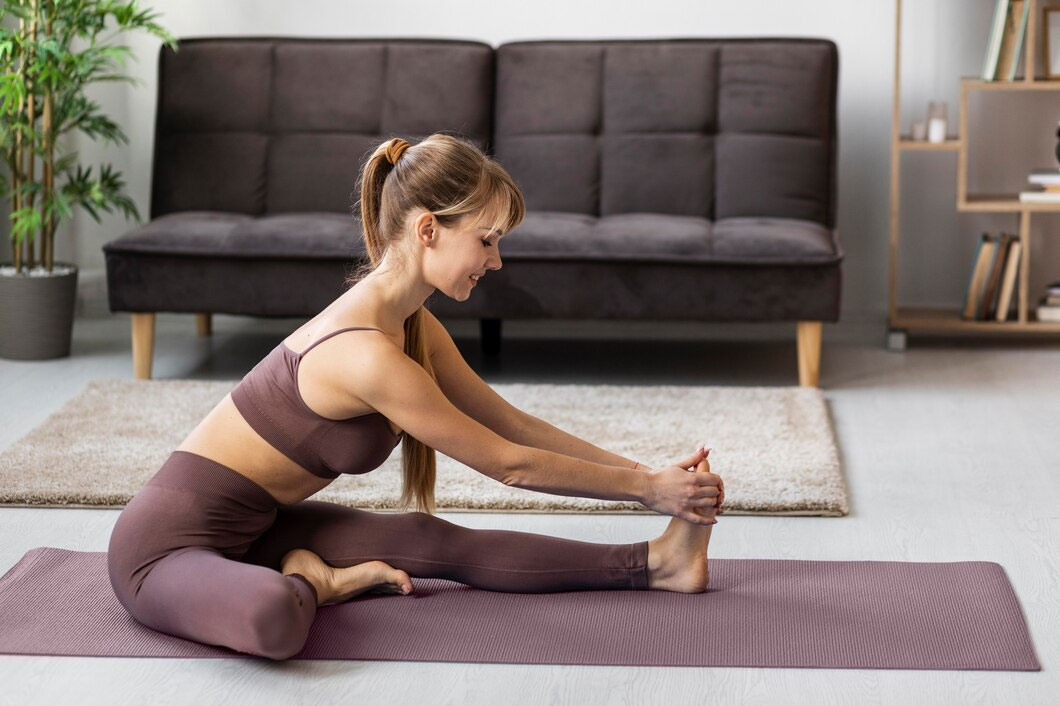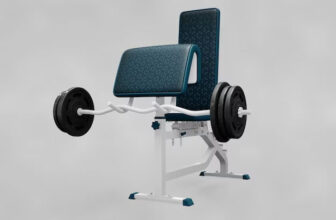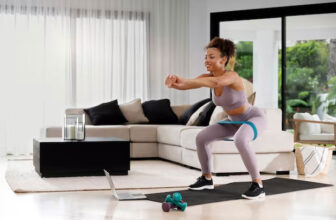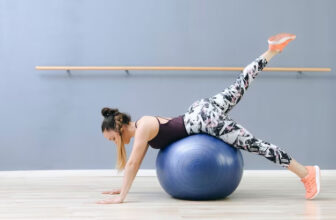
The step-by-step guide titled “How to stretch properly on an exercise mat” aims to provide readers with clear and concise instructions on how to effectively stretch while using an exercise mat. The purpose of this guide is to enable individuals to stretch their muscles in a safe and correct manner in order to improve flexibility, prevent injuries, and enhance their overall workout experience. By following the presented steps, individuals can feel confident in their ability to properly carry out a range of stretching exercises on an exercise mat.
Choosing the Right Exercise Mat
When selecting an exercise mat, it is critical to choose one that offers sufficient support and cushioning for a comfortable workout and to mitigate the risk of injury. A high-quality mat should provide excellent shock absorption and stability. For instance, a yoga mat with a thicker and denser material ensures proper joint protection and helps prevent slipping during poses. Conversely, an exercise mat designed for intense floor workouts should have adequate thickness to cushion the body against impact. Consider the type of exercise you will be doing and the specific support and cushioning needs for that activity to ensure a proper choice of exercise mat.
Preparing the Exercise Mat
Clean and prepare the exercise mat before starting the stretching routine as follows:
- Begin by sweeping the mat to remove any surface debris or loose particles.
- Fill a bucket with warm water and add a mild detergent. Dip a soft cloth or sponge into the soapy water, wring it out, and gently scrub the mat to remove any dirt or stains.
- Rinse the mat thoroughly with clean water, or wipe it down with a damp cloth to remove any soapy residue.
- Allow the mat to air dry completely before using it for your stretching routine.
Starting with Warm-Up Exercises
- Start with Cardiovascular Warm-up: Begin your warm-up routine with some cardiovascular exercises to get your heart rate up and boost blood flow to your muscles. Include activities like jogging on the spot, jumping jacks, or skipping.
- Dynamic Stretching: Next, move on to dynamic stretching to increase flexibility and range of motion. Perform exercises like arm circles, hip rotations, or walking lunges to target different muscle groups.
- Joint Mobilization: Foster mobility in your joints by incorporating exercises like ankle rolls, wrist circles, and neck rotations. This will help prepare your joints for the subsequent stretching on the exercise mat and reduce the risk of injury during exercise.
- Core Activation: Strengthen your core and optimize your stability by incorporating exercises like planks or opposing limb extensions during your warm-up. This will engage your abdominal muscles and improve your overall posture.
Remember to maintain correct form throughout your warm-up routine, and do not rush each exercise. Each activity should be smooth and controlled, gradually preparing the body for further stretching on the exercise mat.
Stretching the Upper Body
To demonstrate and describe various stretching exercises for the upper body, start with the neck stretch. Slowly tilt your head to the right, feeling the gentle stretch on the left side of your neck. Hold for 15-30 seconds, then repeat on the other side. Next, for shoulders, bring your left arm across your body, using your right arm to gently pull it closer to your chest. Hold for a count of 15, and then switch arms. For the arms, raise one arm straight up and gently bend it at the elbow so your hand is behind your head. Take your opposite arm and reach behind your back, gently assisting the stretch by pressing the raised elbow further towards the head. Same process goes with the other arm. Finally, demonstrate the chest stretch. Clasp your hands behind your back, and slowly lift your arms upward, keeping them straight and lengthening the chest muscles. Remember to keep good form, breathe deeply, and modify any exercises to your own flexibility level. Keep in mind, these stretches should be done in a slow and controlled manner for optimal stretching.
Stretching the Lower Body
The guide “Stretching the Lower Body” illustrates various stretching techniques for the legs such as the following:
- Hamstrings: While standing upright, keep one leg straight and slightly bend the other one. Keeping your back straight, gently reach down towards your toes of the straight leg until you feel a stretch in the back of your thigh. Hold for 20-30 seconds and then switch legs.
- Quadriceps: Stand tall and grab hold of your ankle nearest to your buttocks. Keep your knees close together and ensure that your upper body remains upright. If needed, use a wall or chair for support. Hold the stretch for 20-30 seconds per leg.
- Calves: Place a towel or mat beneath your feet and stand facing a wall. Take one step back with your left leg, keeping the left heel firmly planted on the ground. Lean towards the wall while also pushing the left heel into the ground until a gentle stretch is felt in the calf muscle. Hold this for 20-30 seconds, and then switch legs.
- Hips: Sit on the edge of a chair or bench with your legs extended in front of you. Cross your right ankle and place it on your left knee.Then gently press down your right knee, slight advancing the upper body until you you feel a gentle stretch in your right hip. Continue to hold the stretch for 20-30 seconds, switch sides and repeat.
Remember, take deep breaths during each stretch and do not stretch to the point of pain. Happy stretching!
Core and Back Stretches
Choose a comfortable spot on the exercise mat. Lie down on your back with your feet flat on the ground and your knees bent. Place your hands behind your head and interlock your fingers. Slowly lift your shoulders off the ground and feel the stretch in your core. Hold for a few seconds and then slowly lower yourself back down. Repeat 10 times for an effective core stretch. For a back stretch, lie down on your back with your legs extended. Reach your arms overhead and elongate your body. Slowly bring your right knee towards your chest, using your hands for support. Hold for a few seconds and then switch legs. Repeat 5 times for an invigorating back stretch.
Incorporating Yoga Poses
Incorporating yoga poses into your exercise routine can greatly enhance your flexibility and promote relaxation. Here are a few examples of poses that can be comfortably performed on an exercise mat:
- Child’s Pose (Balasana): Begin by kneeling on the mat with your toes together and knees slightly wider than hip-width apart. Rest your butt on your heels and slowly fold forward, lowering your head towards the mat. Stretch your arms forward or rest them alongside your body. Stay here for a few breaths, allowing your back to relax and releasing any tension from the upper body.
- Downward Facing Dog (Adho Mukha Svanasana): Start on all fours, aligning your hands under your shoulders and knees under your hips. Spread your fingers wide, tuck your toes, and lift your knees off the mat, pressing your hips towards the ceiling. Straighten your legs, keeping a slight bend in the knees if needed, and lengthen your spine. Press downward through your palms and let your head hang freely, relaxing your neck. Hold for a few breaths, focusing on the stretch in your hamstrings and releasing tension from your upper body.
Remember, as you move through each pose, breathe deeply and allow your body to unwind. These examples are just a starting point, so feel free to explore other yoga poses to find the ones that work best for your body and goals.
Maintaining Proper Form and Breathing
Maintaining proper form and breathing is crucial in a stretching routine as it helps align the body correctly, prevent injury, and increase the effectiveness of the exercises. To do this, keep the body aligned and engage the core muscles throughout each stretch. Breathe deeply and consistently, inhaling deeply through the diaphragm and exhaling slowly and fully with each stretch. This allows for optimal oxygen flow to the muscles, helping them relax and elongate.
Cooling Down and Post-Stretching Care
Guide the reader on how to cool down after stretching:
- Walk it off: Take a brisk walk for 5-10 minutes to gradually lower your heart rate.
- Ease into static stretches: Slowly transition from dynamic stretches to static holds by focusing on major muscle groups like legs, arms, and back.
- Controlled breathing: Take slow, deep breaths to help relax your muscles and reduce tension.
- Negative thinking technique: Use positive affirmations and visualization exercises as a part of cooling down your mental state after stretching.
- Drink plenty of water: Stay hydrated during and after your workout to combat post-stretching stiffness and soreness.
Provide tips for taking care of the exercise mat:
- Daily wipe down: After each workout, wipe the exercise mat with a damp cloth to remove sweat and dirt.
- Use a mild sanitizer solution: Regularly sanitize the mat using a mixture of mild soap and warm water. Rinse and air-dry thoroughly before the next use.
- Avoid harsh chemicals: Refrain from using harsh chemicals or abrasive cleaners, as they may deteriorate or stain the mat’s surface.
- Proper storage: Roll the exercise mat up loosely, not too tightly, and store it in a dry and well-ventilated area.
- Protect from sharp objects: Keep the mat away from sharp objects that could puncture or damage it.
The Importance of Proper Stretching
In conclusion, mastering the art of proper stretching techniques on an exercise mat is a decisive way to boost overall flexibility and protect yourself from potential injuries. This guide has highlighted key points such as using the right form, understanding your body’s limits, and implementing dynamic stretches for optimal results. Incorporating these practices into your routine will cultivate a strong foundation of physical health, ensuring a more fruitful exercise journey. Through regular and mindful stretching on an exercise mat, you will not only improve your flexibility but also enhance your performance, prevent injuries, and unlock new realms of athletic potential. So, seize the power of proper stretching and elevate your fitness journey to new heights. Stretch right, move as never before!
Essential Equipment
Master Your Mat
Image by Freepik







